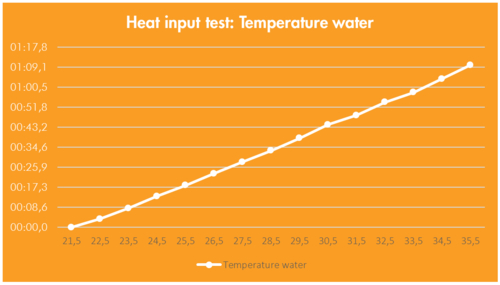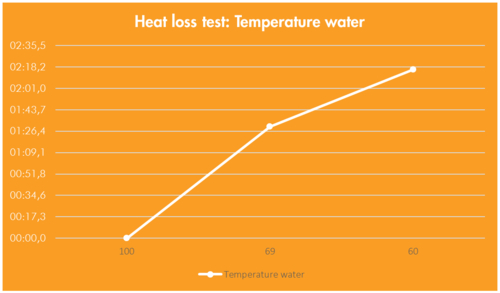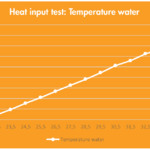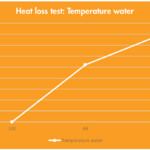Wood Gas Stove
The Wood Gas Stove burns natural fuels, like wood or pellets, very efficient and clean. The fuel burns from the top down and should be kindled with an inflammable material. Jan Kluiver designed a DIY version of the Wood Gas Stove and used pellets as a fuel, because they burn longer for their high density. The upper pellets are soaked in methylated spirit to kindle the pellets from the top down.
We performed five tests with the Wood Gas Stove to check if the stove was suitable for the Fortune Cooker. Three tests were performed with pellets, one with chopped fire sticks and one with the help of Moroccan neighbours who assembles twigs as a fuel. The former four tests were performed using sawdust to kindle the fuel, because we could not find methylated spirit. The latter test used dried leaves as a lighter.
Test 1 - 4
The Wood Gas Stove was filled for two-third with pellets/chopped fire sticks. Above that a layer of sawdust was placed up to the holes in the stainless steel cup and kindled. Once the sawdust kindled the pellets/chopped fire sticks, the fan was started. At this point the fire started to produce a lot of smoke. The heat could easily be felt with your hands directly above the Wood Gas Stove, which indicated there was not enough warmth to cook with. Both fuels turned into charcoal pieces after about half an hour.
Test 5
The neighbours decided to help us built a fire in the Wood Gas Stove as they saw us struggling. They broke twigs into small pieces and filled the stainless steel cup entirely. Both neighbours made clear it was very important to add oxygen to the fire through the holes and that the hole should therefore be places halfway the height of the cup.
Dried leaves were used to kindle the twigs. Once the fire started, there was a little bit of smoke. The smoke however disappeared soon and the flames got bigger. The twigs turned into charcoal after about 15 minutes. The warmth of the fire seemed sufficient for cooking, but the flames got much bigger than intended for cooking with the Wood Gas Stove.
General information
All tests are executed with 2 litres of water.
All calculations are made with the specific heat of water, which is 4200 J/Kg/K.
The used formula is: c (specific heat) × V (volume, in litres) × ΔT (temperature difference) / t (time, in seconds).
We assume that sunlight has an intensity of 1000 W/m2 (Ternary.eu, 2016). This is approximately the intensity of the sun in the summer in the Netherlands, so the sun intensity in Morocco should be at least this intensity, also on cloudy days.
According to the Solar Electricity Handbook (2016), the average solar insulation in December is less than twice as low than in June, considering the Fortune Cooker as a solar panel optimally adjusted to the sun. Thus, the sun radiation would reach around 500 W/m2 in December.
The glass surface is 0,39*0,33 = 0,132 m2. This comes down to 500*0,132 = 66 Watt.
Taking heat loss through the glass and cracks into account, estimated at 20%, 52,8 Watt remains. This is the number that could theoretically be reached with the prototypes. If not, the design of the prototype or the used pan is not good enough to meet its technical demands and therefore should be adapted.
HEAT INPUT
With the second prototype we first tested the heat input with a shining pan. Hereby we could compare the two prototypes to see if the height difference would have a positive influence on the amount of solar energy that the box absorbs. Afterwards, we tested the heat input with a black pan, to see if this would deliver better results on the temperature increase of the water in the pan.
Test 1 (with shining pan)
Start time: 13:39
Results
Temperature increase 14 Degrees Celsius
Amount of time needed 6915 seconds
Watts 17,0 Watt 4200 × 2 × 14 / 6915
Test 2 (with black pan)
Start time: 14:09
Results
Temperature increase 14 Degrees Celsius
Amount of time needed 4213 seconds
Watts 27,9 Watt 4200 × 2 × 14 / 4213
During the second test we measured the time needed for each temperature increase of one Celsius degree. In this way, it becomes clear if the water for example cools down faster in the beginning than in the end or if there is a linear relation. The graph of this data is given below:
This graph shows that the relation between the increase of the temperature and the time is fairly linear, so when the Fortune Cooker stands in the sun longer, the water will also increase in temperature.
Heat input:
Around 17,0 Watt with a shining pan and around 28 Watt with a black pan.
HEAT LOSS
Test 1
Start time: 13:39
Results
Temperature decrease 31 Degrees Celsius
Amount of time needed 5415 seconds
Watts 48,09 Watt 4200 × 2 × 31 / 5415
Continuation
Temperature decrease 9 Degrees Celsius
Amount of time needed 2756 seconds
Watts 27,43 Watt 4200 × 2 × 9 / 2756
Average
Temperature decrease 40 Degrees Celsius
Amount of time needed 8171 seconds
Watts 41,12 Watt 4200 × 2 × 40 / 8171
As described with the tests of prototype 1, this graph shows that the water cools down faster in the beginning than in the end.
Heat loss:
Over a time span of about two hours, the heat loss is around 40 to 45 Watt. Also, the temperature decreases less over time.
Conclusions on the technical results of prototype 2:
Regarding the heat input, the lowered height of prototype 2 compared to the first prototype did not positively influence the amount of solar energy absorption, as the outcome of 17 Watt is the same as the outcome of prototype 1.
On the other hand, the use of the black pan did influence the solar energy absorption in a positive way, as this test resulted in an input of around 28 Watt.
This amount of Watts is still half of the theoretically possible 53 Watts, which means there still is an error in the design of the product and this should be researched and adapted. However, this amount of input could be enough for the Fortune Cooker to work well in the summer or in other areas of Morocco or even other countries, given solar power is higher.
The heat loss is about the same as it was with the first prototype, around 40-45 Watt. In the second prototype cracks are closed with kit. However, this did not seem to improve the insulation of the box. A reason for this could be the fact that the door (used in prototype 2) closes less than the drawer (used in prototype 1). The temperature decreases less over time.



